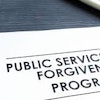The window created by the Limited Public Service Loan Forgiveness (PSLF) Waiver will close in four months, and the American Association of Colleges and Universities (AAC&U) wants to make sure academics get a chance to receive the waiver’s benefits.
“Most college and university full time employees are now eligible under the PSLF program,” said Kathryn Enke, secretary to the board and strategist for presidential initiatives at the AAC&U.
Enke welcomed campus leaders and student loan borrowers by the hundreds to a webinar focused on helping those working at public or non-profit institutions understand just how to apply for this forgiveness, and to do so well before the waiver ends on Oct. 31, 2022.
 Ashley Harrington, senior advisor to the chief operating officer at the U.S. Department of Education's Office of Federal Student Aid.
Ashley Harrington, senior advisor to the chief operating officer at the U.S. Department of Education's Office of Federal Student Aid.
The waiver makes many changes to the traditional rules that outline PSLF. Provided that a borrower’s loans are consolidated into a Direct Consolidation Loan before Oct. 31, the waiver allows any period of past repayment to count towards PSLF. And, even if payments have been late or under expected amounts, they will still count as credit toward the required 120 payments needed to receive PSLF.
“You can now get credit for time in repayment when it was a Federal Family Education Loan program (FFEL) or a Perkins loan,” said Ashley Harrington, senior advisor to the chief operating officer at the Office of Federal Student Aid. Before the waiver, FFEL and Perkins loans did not qualify for PSLF payment credit.
Harrington spoke to attendees not only as an expert, but as a borrower herself. Harrington borrowed as a graduate student to attend New York University’s School of Law.
“We don’t care what payment plan you’re on. All we care about is whether you are in active repayment status, which we define generously,” said Harrington. “We don’t care if you were late, missed a payment, or it was a dollar short, as long as you weren’t in default, or in-school deferment.”
Before the Limited PSLF Waiver, borrowers could only receive PSLF if they were currently employed in a place of public service. As defined by the PSLF rules, qualifying public service employment is offered by non-profits or government agencies, which includes teaching at public schools and working in the military.
Now, the waiver allows borrowers to apply for loan forgiveness even if they do not currently work at a qualifying place of employment. It also allows individuals gaps between public service jobs. As long as the individual applying can prove they worked a total of at least 30 hours a week, even at multiple jobs, they can still qualify for PSLF credit.
“If I work part-time at a university and part-time at a state agency and do 15 hours a week at each, that’s 30 hours a week,” said Harrington. “We’re not going to ask what you do. All we care about is who pays you.”
While many student loans were paused by the federal government during COVID, Harrington reminded those in attendance that PSLF credit for payment will still be given even if a borrower made zero payments during the pause.
“It doesn’t seem to make sense, and it doesn’t seem it should be that way, but as long as you were still employed full time, even if you didn’t pay anything, you can get credit for every one of those months, I promise,” said Harrington.
Receiving credit from the COVID-related pause means that the average PSLF candidate will receive 20% of their qualifying 120 payment credits without spending a penny, something Harrington said is “a really big deal.”
“Get your forms in now, do not wait,” said Harrington. “Right now, you can consolidate older and newer loans and get credit. But after Oct 31, that’s not the case.”
Liann Herder can be reached at [email protected].



















